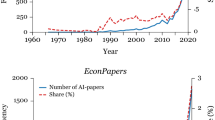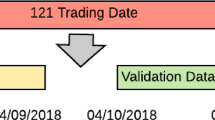Abstract
Since economic trends have a great influence on corporate activities, predicting whether the economy is in an expansion period or in retreat is important. Business condition indexes used in Japan that quantify the economy include the diffusion index (DI) and the composite index (CI). A method for predicting economic judgement is presented in this study. An economic trend is taken as an objective function and the DI and CI values are explanatory variables. The prediction model is defined as a Bayesian network. In Bayesian networks, random variables are used as nodes, and the dependency between variables is represented by a directed graph. Japan’s economic trends and DI and CI values from 1985 to 2020 are taken as experimental data. The forecast model is determined using the data from 1985 to 2017 as learning data, and the economic trend from 2018 to 2020 is predicted. The proposed algorithm is compared with a linear model for time-series data. The proposed algorithm shows better accuracy than the linear models.









Similar content being viewed by others
References
Robinson, R. W. (1977). Counting Unlabeled Acyclic Digraphs. Lecture Notes in Mathematics, 622, 28–43.
Klenke, A. (2008). Probability Theory: A Comprehensive Course, Springer
Bookstaber, R. (1985). The complete investment book: Trading stocks, bonds, and options with computer applications. Scott Foresman Trade
Whittle, P. (1983). Prediction and regulation by linear least-square methods. University of Minnesota Press, ISBN 0-8166-1148-3.
Hannan, E. J., & Deistler, M. (1998). Statistical theory of linear systems. Wiley series in probability and mathematical statistics. Wiley.
Brockwell, P. J., & Davis, R. A. (2009) Time Series: Theory and Methods (2nd ed.), Springer. ISBN 9781441903198.
Box, G., Jenkins, G. M., & Reinsel, G. (1994). Time series analysis: Forecasting and control. Prentice-Hall
Sasaki, H., & Urano, M. (2020). Economic Trend Index Forecasting Using Multiple Regression Model and Random Forest, Proceedings of The 34th Annual Conference of the Japanese Society for Artificial Intelligence, Vol.JSAI2020, 2I1GS202-2I1GS202
Sakaji, H., Sakai, H., & Masuyama, S. (2007). Extraction and analysis of basis expressions that indicate economic trends. Information Processing Society of Japan, Special Interest Group of Natural Language Processing (IPSJ-SIGNL), 0919-6072, Vol. 180, 151–156.
Kaku, K., & Neki, S. (2014). Study of Economic interconnectedness analysis in Pacific Rim’s Countries by Using Stock index. Proceedings of the School of Information and Telecommunication Engineering Tokai University, 7(2), 44–51 ((in Japanese)).
Pearl, J. (1985). Bayesian Networks: A Model of Self-Activated Memory for Evidential Reasoning, (UCLA Technical Report CSD-850017). Proceedings of the 7th Conference of the Cognitive Science Society, University of California, Irvine, CA. pp. 329-334. Retrieved 2009-05-01
Neapolitan, R. E. (1985). Probabilistic reasoning in expert systems: Theory and algorithms. Wiley. ISBN 978-0-471-61840-9.
Pearl, J. (1988) Probabilistic Reasoning in Intelligent Systems. Morgan Kaufmann. ISBN 978-1558604797.
Cooper, G. F. (1990). The computational complexity of probabilistic inference using Bayesian belief networks. Artificial Intelligence, 42(2–3), 393–405. https://doi.org/10.1016/0004-3702(90)90060-d.
Heckerman, D., Geiger, D., & Chickering, D. (1995). Learning Bayesian Networks : The Combination of Knowledge and Statistical Data. Machine Learning, 20, 197–243.
Neapolitan, R. E. (2004). Learning Bayesian networks. Prentice Hall. ISBN 978-0-13-012534-7.
Zuo, Y., & Kita, E. (2012). Stock price forecast using Bayesian network. Expert Systems with Applications, 39(8), 6729–6737.
Hannan, E. J. (1970). Multiple time series. Wiley series in probability and mathematical statistics. John Wiley and Sons
Brockwell, P. J., & Davis, R. A. (2009). Time series: Theory and methods. Springer
Terasvirta, T., Tjostheim, D., & Granger, C. W. J. (2011). Modeling nonlinear economic time series. Oxford University Press
Author information
Authors and Affiliations
Corresponding author
Additional information
Publisher's Note
Springer Nature remains neutral with regard to jurisdictional claims in published maps and institutional affiliations.
Rights and permissions
Springer Nature or its licensor holds exclusive rights to this article under a publishing agreement with the author(s) or other rightsholder(s); author self-archiving of the accepted manuscript version of this article is solely governed by the terms of such publishing agreement and applicable law.
About this article
Cite this article
Nakamura, N., Kita, E. The Application of Bayesian Estimation for the Prediction of Economic Trends. Rev Socionetwork Strat 16, 239–258 (2022). https://doi.org/10.1007/s12626-022-00114-y
Received:
Accepted:
Published:
Issue Date:
DOI: https://doi.org/10.1007/s12626-022-00114-y




